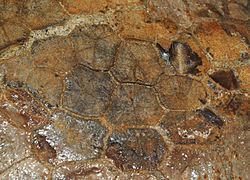Phylum Chordata Order Turtle | Class Sauropsida Rank Genus | |
 | ||
Similar Eosphargis, Protosphargis, Glarichelys, Gigantatypus, Mesodermochelys | ||
Psephophorus is an extinct genus of sea turtle that lived from the Oligocene to the Pliocene. Its remains have been found in Europe, Africa, North America, and New Zealand. It was first named by Hermann von Meyer in 1847, and contains seven species, P. polygonus, P. calvertensis, P. eocaenus, P. oregonesis, P. californiensis, P. rupeliensis, P. scaldii, and a species discovered in 1995, P. terrypratchetti.
Contents
Psephophorus is the only Miocene dermochelyid turtle found in Europe. One species of Psephophorus could measure up to ten feet in length.
Discovery and identification
Von Meyer originally called Psephophorus "Jahrbuch" in 1846. At first he was unable to identify the creature beyond its dermal plates, but when he later received a drawing he was able to describe the specimen, which was then in Pressburg, as a fragment of a carapace, which contained seventy bones.
In 1879, Professor H.G. Seeley was asked to study the Psephophorus specimen by Franz Ritter von Hauer, the Director of the Austro-Hungarian Imperial and Royal Geological Survey. Up until then, the specimen's identity had been undeterminable, with even Seeley describing it at first to seem like "the dermal covering of an Edentate closely allied to the Armadilloes." Seeley examined some bone fragments and concluded the specimen was that of a reptilian creature, furthermore a chelonid. It also proved to be more closely related to Sphargis than any other type in the Chelonian order.
Relation to modern Leatherback sea turtles
For a long time, modern Leatherback sea turtles (Dermochelys) were believed to be descended directly from Psephophorus, specifically the species P. polygonus. However, a 1996 analysis by Wood et al. proved that most of the taxa in the two genera were not connected, meaning Psephophorus could not be a direct ancestor of the modern leatherbacks. The platelets on Psephophorus are quite similar to those on Dermochelys, despite differences in outer morphology and size. The platelet comprises an external compact layer and an internal zone of cancellous bone.
